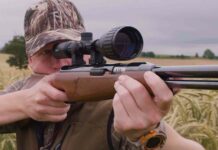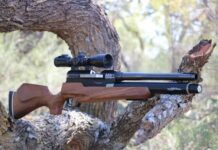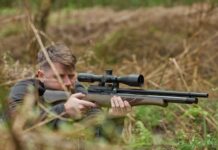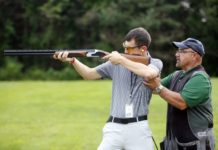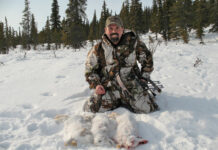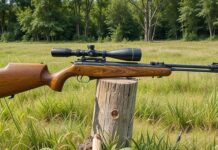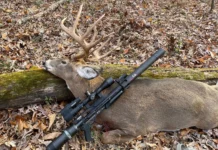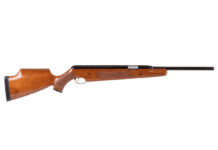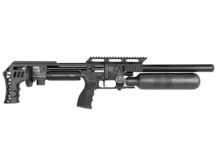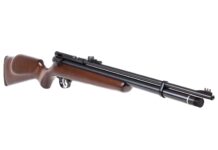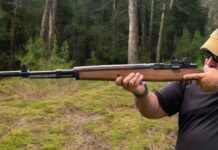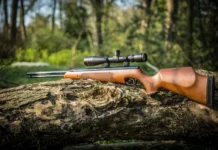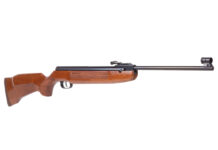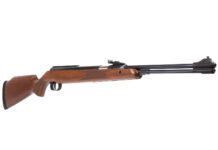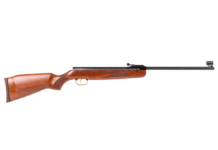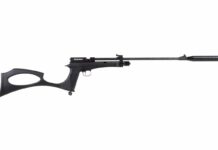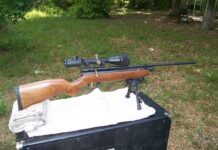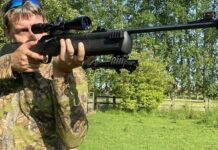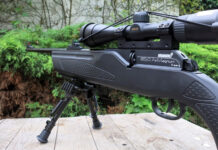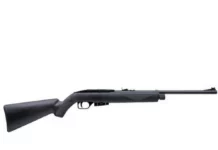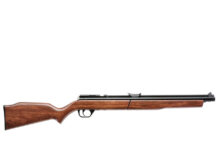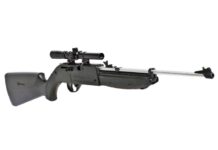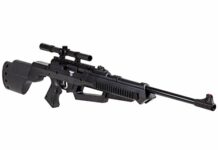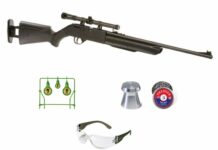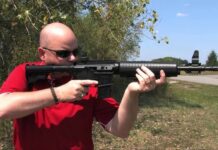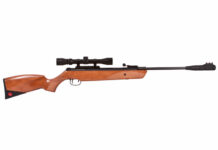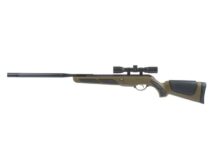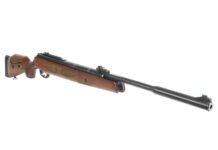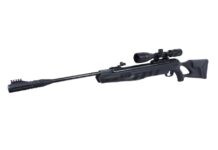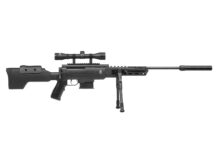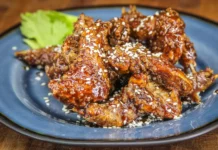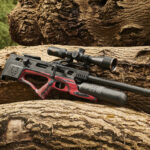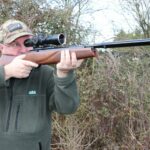Table of Contents
- 1 243 vs 308 vs 7mm-08 Podcast
- 1.1 243 vs 308 vs 7mm-08: History
- 1.2 243 vs 308 vs 7mm-08: Cartridge Sizes
- 1.3 243 vs 7mm-08 vs 308 Ballistics
- 1.4 243 vs 308
- 1.5 7mm-08 vs 243
- 1.6 7mm-08 vs 308
- 1.7 243 vs 308 vs 7mm-08: Ammunition Selection
- 1.8 243 vs 308 vs 7mm-08: Rifle Selection
- 1.9 243 vs 308 vs 7mm-08: Which Is Right For You?
- 1.10 NEXT: BEST 6.5 CREEDMOOR AMMO FOR HUNTING DEER, ELK, AND OTHER BIG GAME
- 1.11 Enjoy this article about the 243 vs 308 vs 7mm-08 debate? Please share it with your friends on Facebook and Twitter.
The .243 Winchester and 7mm-08 Remington use a modified .308 Winchester case and are designed to improve upon their parent cartridge. Here’s what you need to know about the 243 vs 308 vs 7mm-08 cartridges.
I think most hunters would agree that the .243 Winchester, 7mm-08 Remington, and .308 Winchester are all excellent cartridges for hunting a wide variety of game. After all, there’s a reason why they are such popular North American big game hunting cartridges. However, even though they are similar in many ways, there are some big differences between the 243 vs 308 vs 7mm-08 cartridges that you should be aware of.
The .308 Winchester is an excellent cartridge, but that hasn’t stopped wildcatters from attempting to improve upon it over the years in various ways. The .243 Winchester and 7mm-08 Remington are the two most popular examples of cartridges developed by necking down the .308 Winchester to shoot smaller diameter bullets. While each of the three cartridges offer certain benefits to hunters, it’s still easy to get confused when trying to understand their true strengths and weaknesses.
In this article, I’m going to discuss the pros and cons of the 243 vs 308 vs 7mm-08 cartridges so you can make an informed decision on which one is right for you.
Before we get started, I have an administrative note:
Some of the links below are affiliate links. This means I will earn a small commission (at no extra cost to you) if you make a purchase. This helps support the blog and allows me to continue to create free content that’s useful to hunters like yourself. Thanks for your support.
Additionally, I recorded an entire podcast episode on this exact subject. If you’d rather listen than read, click the appropriate link below to listen to this episode on your preferred podcasting service.
243 vs 308 vs 7mm-08 Podcast
Apple | Google | iHeart | Spotify | Stitcher
243 vs 308 vs 7mm-08: History
The .30-06 Springfield has been one of the most popular and effective hunting cartridges in North America ever since it first hit the civilian market in the early years of the 20th Century. Even though it also performed very well in the hands of American Soldiers and Marines in World War II, leaders in the military began looking for a replacement for the .30-06 after the war.
They eventually settled on the 7.62x51mm NATO round in the 1950s.
The original 7.62x51mm M80 ball load fired a .308″ 147 grain full metal jacket (FMJ) bullet at 2,750 feet per second (2,469 foot pounds of energy). The cartridge also had virtually the same ballistics as the original .30-06 Springfield load (150 grain bullet at 2,700 feet per second), but achieved that same level of performance with a shorter case length (51mm vs 63mm) due to advances in powder technology that occurred after the development of the .30-06.
Winchester identified significant commercial potential for the new cartridge during the development process of the 7.62x51mm and introduced the extremely similar .308 Winchester cartridge for the civilian hunting and shooting markets in 1952. Since the new .308 Winchester essentially duplicated the performance of the .30-06 while using a smaller case, the new cartridge was a big hit with many American hunters and shooters.
If you’d like to read a more detailed discussion on how the .308 Winchester stacks up next to the .30-06 Springfield, read this article:
308 vs 30-06 vs 300 Win Mag: Which Cartridge Should You Be Hunting With?
Though the .308 Winchester developed a reputation for accuracy, power, and efficiency with hunters and shooters, wildcatters and gun designers started modifying the .308 Winchester to develop new and more specialized cartridges almost immediately after it hit the market. Experiments with necking down the .308 to shoot smaller, .243″ bullets yielded one of the first (if not the very first) cartridges descended from the .308 Winchester in 1955: the .243 Winchester.
Similar to the difference between the 7-30 Waters and the .30-30 Winchester (or the .25-06 and the .30-06), by necking down the .308 case to shoot smaller caliber bullets, the designers of the .243 Winchester built a cartridge with a higher velocity, flatter trajectory, and less recoil than the .308 Winchester.
The new .243 Winchester really caught on with a segment of the hunting population that wanted a flat shooting and light recoiling rifle cartridge that was still powerful enough to hunt big game like deer and pronghorn. Capable of shooting heavy as well as light bullets with very good accuracy, the .243 Winchester was also a great varmint hunting cartridge and successfully bridged the gap between traditional varmint cartridges of the day like the .22 Hornet and popular big game hunting cartridges like the .30-06 Springfield.
While the .243 Winchester was indeed a well designed and very effective cartridge, there are plenty of good cartridges that don’t experience commercial success for one reason or another. Fortunately for the .243 Winchester, Field & Stream editor Warren Page extolled the virtues of the .243 in his columns in a manner similar to what Jack O’Connor did for the .270 Winchester at Outdoor Life.
Page’s columns certainly helped drive demand for the .243 Winchester. The .243 also got something of an unintended assist from Remington when they released the competing .244 Remington the same year Winchester released the .243. Designed by necking down a .257 Roberts case (itself a necked down 7x57mm Mauser) to .243 caliber, the .244 Remington had a small ballistic advantage over the .243 Winchester.
However, company made the unfortunate initial decision to use a slower 1:12″ rifling twist in their .244 Remington rifles. These rifles were unable to stabilize the longer 100gr bullets that were best suited for use on big game. Since Winchester produced their .243 rifles with a faster twist rate of 1:10″, they could accurately shoot heavier bullets and were thus much more versatile than the .244 Remington initially.
Remington renamed the .244 the 6mm Remington a few years later and started producing rifles with a 1:9 twist rate, but the damage had already been done and the .243 Winchester was already well established and had claimed the majority of the 6mm centerfire rifle market share.
The .244/6mm Remington was not a commercial success for the company, but Remington got the chance for redemption a few decades later when they finally legitimized another wildcat derivative of the .308 Winchester. Wildcatters had been necking down the .308 Winchester to 7mm for years, but for reasons that aren’t totally clear, no company had ever standardized a 7mm cartridge based on the .308 until the Remington Arms Company released the 7mm-08 Remington in 1980.
The 7mm-08 Remington uses the same .284″ bullets as the 7mm Mauser and the 7mm Remington Magnum and fills the gap between the .243 Winchester and the .308 Winchester. It has less recoil and a flatter trajectory than the .308, but is more powerful and uses larger and heavier bullets than the .243.
If you’d like to read a more detailed discussion on how the .308 Winchester stacks up against two cartridges that used a necked up .308 Winchester case in the .338 Federal and .358 Winchester, read this article:
338 Federal vs 308 Winchester vs 358 Winchester: What You Need To Know
243 vs 308 vs 7mm-08: Cartridge Sizes
You can see some of the similarities and differences between the .243 Winchester, the 7mm-08 Remington, and the .308 Winchester cartridges in the photo below.
Their shared heritage is evident and the three cartridges are identical up to the shoulder. All three cartridges also have the same 20 degree shoulder angle. The .243 has a tiny bit longer case than the 7mm-08, which has a slightly longer case than the .308 (2.045″ vs 2.035″ vs 2.015″), but the .308 has the greatest overall length by a very small margin.
All three cartridge are used in short-action rifles. Indeed, the .308 Winchester is the poster child for the short-action rifle. Since the .308 Winchester is the parent case for the .243 and 7mm-08, all three cartridges have the same rim .473″ diameter.
Not surprisingly, all three cartridges have virtually the same case capacity.
They also have very similar maximum SAAMI pressures of 60,000, 61,000, and 62,000psi respectively.
Note: while the case capacity figures listed below do give a good indication of the differences between the three cartridges, exact case capacities vary slightly according to the brand of brass used.
243 vs 7mm-08 vs 308 Ballistics
Even though the cartridges share the same roots, there is a pretty big difference in the ballistics of each cartridge that reflects the different priorities wildcatters had when designing the .243 and 7mm-08.
The table below compares 55gr Nosler Varmageddon (.252 BC), 90gr Hornady ELD-X (.409 BC), and 100gr Winchester Power Point (.356 BC) loads in .243 Winchester to 120gr Nosler Ballistic Tip (.417 BC), 140gr Winchester Power Point (.360 BC), and 150gr Hornady ELD-X (.574 BC) loads in 7mm-08 Remington, and 150gr Winchester Power Point (.294 BC), 165gr Nosler Ballistic Tip (.475 BC) and 178gr ELD-X (.552 BC) loads in .308 Winchester.
This data is for Hornady, Nosler, and Winchester factory ammo using a 200 yard zero.
Just like you’d expect, the .243 Winchester loads have a higher velocity and flatter trajectory than the 7mm-08 Remington loads, which in turn fire bullets at a higher velocity and with a flatter trajectory than the .308 Winchester loads. Even discounting the extremely high velocity 55gr .243 varmint load as an outlier, the .243 still shoots a lot flatter than the other cartridges.
For instance, the ELD-X from the .243 hits 6.4″ higher than the 7mm-08 ELD-X and 13.7″ higher than the .308 ELD-X at 500 yards. The .243 Winchester Power Point load hits 6″ and 12″ higher than the same style bullet from the 7mm-08 and .308 respectively.
However, the .308 Winchester loads compared here have about 5-20% more muzzle energy (94-474 ft-lbs) than the 7mm-08 loads and 30-65% more muzzle energy (666-94-1,109 ft-lbs) than the .243 Winchester loads. The 7mm-08 loads have around 20-45% more muzzle energy (415-792 ft-lbs)than the .243 loads. At the same time, due to the fact that the cartridge uses the most aerodynamic bullets, the 7mm-08 loads retain a greater percentage of their muzzle energy at long range than the .243 or .308.
The chart below compares how much a 10 mile per hour crosswind impacts the high BC ELD-X loads for each cartridge out to 500 yards.
The superior ballistic coefficient of the 7mm-08 Remington helps give that cartridge an advantage over the two other cartridges in terms of wind drift. The 7mm-08 Remington load has about 2.4″ less drift than the .308 Winchester and 3.8″ less drift than the .243.
As you can see, each cartridge has distinct strengths and weaknesses.
The .243 Winchester has the flattest trajectory of the bunch, but starts off with markedly less kinetic energy than the other two cartridges and carries even less of that energy downrange. The 7mm-08 Remington splits the difference between the .243 Winchester and .308 Winchester in terms of trajectory and muzzle energy and generally the least susceptible to wind drift out of the bunch. The .308 carries significantly more energy downrange than the other two cartridges
All that being said, these cartridges all still hit hard enough and have a flat enough trajectory that they’re suitable for use of a variety of game at practical hunting ranges.
There is more to the story than just comparing the external ballistic performance of each cartridge though.
For instance, the .308 Winchester isn’t a hard recoiling cartridges by any stretch of the imagination, but the .243 Winchester, and to a lesser extent, the 7mm-08 Remington both have very well deserved reputations for mild recoil. For example, when fired from a Ruger American rifle, a 140gr Nosler Partition from the 7mm-08 has nearly 75% more free recoil energy than a .243 Winchester load firing an 85gr Nosler partition. Using the same rifle, a 165gr Nosler Partition from the .308 Winchester has over twice the free recoil energy of the .243 Winchester.
Felt recoil will vary from shooter to shooter and rifle to rifle, but free recoil energy is still a useful way to compare cartridges.
Most shooters should be able to handle the recoil of all three cartridges, but the .243 Winchester has a big advantage in this respect. Don’t underestimate the impact that recoil has on the ability of a person to shoot accurately either. Some people do handle recoil better than others, but all other things being equal, they will absolutely shoot more accurately with a milder recoiling cartridge.
As we previously discussed, the three cartridges fire bullets of drastically different sizes and weights: the .243 Winchester uses .243″ bullets, the 7mm-08 Remington uses .284″ bullets, and the .308 Winchester uses .308″ bullets.
The .243 Winchester cartridge most often uses bullet weights in the 55-115 grain range, with 55, 87, 90, and 100 grain bullets being the most common. 7mm-08 Remington factory loads most often use 120-160 grain 7mm bullets and 120, 140, 150, and 160 grain bullets are the most common. Finally, typical .308 Winchester factory loads use bullets in the 110-180 grain range. 150 grain, 165 grain, 168 grain, and 180 grain bullets are the most popular.
The .284″ bullets of the weights used by the 7mm-08 Remington strike a good balance that results in a better BC and higher sectional density than the bullets used by the .243 and .308.
Sectional density (SD) is a measure of the ratio of the diameter of a projectile to its mass. All other things equal, a heavier projectile of a given caliber will be longer and therefore have a higher sectional density and consequently penetrate deeper than projectiles with a lower mass and sectional density.
As an example, 150 grain and 160 grain .284″ bullets have sectional densities of .266 and .284 respectively. This compares favorably to 150 grain, 165 grain, and 180 grain .308″ bullets which have sectional densities of .226, .248, and .271 respectively. The same also goes for 90 and 100 grain .243″ bullets with sectional densities of .218 and .242 respectively.
That being said, while it does have a small edge in terms of sectional density, the 7mm-08 Remington doesn’t “punch above its weight” to nearly the degree of cartridges like the 6.5 Swede or 9.3x62mm Mauser.
At the same time, the .308 Winchester uses larger diameter bullets than the other two cartridges. Consequently, it has about 18% more frontal surface area (also known as cross sectional area) than the 7mm-08 Remington and over 60% more frontal surface area than the .243 Winchester (.0745 vs .0633 vs .0463 square inches). The 7mm-08 has about 37% more frontal surface area than the .243 Winchester. All other things being equal, a bigger bullet will make a bigger hole, cause more tissue damage, and result in more blood loss.
The .243 Winchester, 7mm-08 Remington, and .308 Winchester have all seen extensive use during practical and/or long range shooting competitions. It’s tough to pick an accuracy winner out of the three, but it’s very safe to say that all are extremely accurate in the right hands at typical hunting ranges.
If you’d like to learn more about the 6.5 Creedmoor, a cartridge specifically designed for longer distance competition shooting, read this article:
6.5 Creedmoor vs 308 Winchester Debate Settled
So where do we stand overall with these cartridges?
With the flattest trajectory and mildest recoil of the three, the .243 Winchester has a definite edge in those two categories. These factors make the cartridge more forgiving of range estimation errors and help maximize the shooting abilities of the hunter to a greater extent than the other two cartridges.
However, the .308 carries more energy downrange than and, since it has a larger bullet diameter, has significantly more frontal surface area than the other two cartridges. Those traits give hunters a tiny bit more room for error in shot placement when compared to the .243 Winchester and 7mm-08 Remington. Those characteristics are also helpful when hunting larger game.
Finally, the 7mm-08 Remington strikes a good balance: it uses a larger and heavier bullet that carries more energy downrange than the .243 Winchester, but has a whole lot less recoil than the .308 Winchester. The 7mm-08 Remington also generally uses higher SD and higher BC bullets that will penetrate deeper and more reliably, resist wind drift better, and do a better job of retaining energy at longer range than the .308 or .243.
Here’s how each cartridge compares directly to the others in general terms.
243 vs 308
The 243 shoots lighter and smaller diameter bullets at a higher velocity. For this reason, the .243 Winchester has less recoil and a flatter trajectory at typical hunting ranges. On the other hand, the heavier and larger diameter .308 Winchester bullets have more frontal surface area, more resistance to wind drift, and carry more energy down range.
7mm-08 vs 243
The 7mm-08 uses heavier, larger diameter, and more aerodynamic bullets that have a higher sectional density, more frontal surface area, more resistance to wind drift, penetrate better, and carry more energy down range than the .243 Winchester. On the other hand, the .243 has less recoil and (usually) a flatter trajectory at common hunting ranges.
7mm-08 vs 308
The 7mm-08 Remington shoots lighter, smaller diameter, and more aerodynamic bullets with a higher sectional density faster than bullets used by the .308 Winchester. Therefore, the 7mm-08 has less recoil, a flatter trajectory, penetrates better, and has less wind drift at typical hunting ranges. Typical .308 bullets have more frontal surface area and carry more energy down range though.
Yes, I’m really nitpicking the strengths and weaknesses of the these cartridges.
They are all very accurate, relatively flat shooting, and hit hard enough for use on a variety of game at reasonable hunting ranges. Regardless of whether you’re using a .243 Winchester, a 7mm-08 Remington, or a .308 Winchester, no pronghorn or deer will go far if you put a well constructed bullet into the vitals.
243 vs 308 vs 7mm-08: Ammunition Selection
The .243 Winchester, 7mm-08 Remington, and .308 Winchester are all very popular hunting cartridges and ammo availability for them is generally not an issue during normal times. However, the .308 Winchester is still by far the most widely used and the .243 Winchester is a distant second, but both still rank among the Top 10 in ammunition sales in the USA each year. The 7mm-Remington is relatively widely used as well, but really lags behind the other two.
The big ammunition manufacturers like Barnes, Browning, Federal Premium, Hornady, Nosler, Remington, and Winchester all produce a variety of quality .243 Win, 7mm-08 Rem, and .308 Win factory ammunition suitable for hunting.
Most of the highly regarded bullet types specifically designed for big game hunting are available in those three cartridges as well like the Barnes TTSX, the Hornady ELD-X, GMX, InterLock, and SST, the Nosler AccuBond, E-Tip, and Partition, the Remington Core Lokt, and the Winchester Power Point. Predator and varmint rounds like the Hornady V-Max and Nosler Varmageddon are also commonly available for the .243 Winchester.
Prices and availability vary, but ammunition for all three cartridges is widely available. The .308 Winchester is the most common and the least expensive, followed by the .243 Winchester and then the 7mm-08 Remington.
BUY SOME EXCELLENT 243 WINCHESTER HUNTING AMMO HERE
BUY SOME HIGH QUALITY 7mm-08 HUNTING AMMO HERE
BUY MORE 7mm-08 HUNTING AMMO HERE
BUY SOME GREAT 308 WINCHESTER HUNTING AMMO HERE
Read the articles below if you’d like to learn more details about some of the various hunting ammunition choices for the .243 Winchester, 7mm-08 Remington, and .308 Winchester.
Best 243 Ammo For Hunting Deer, Hogs, And Varmints
Best 7mm-08 Remington Ammo For Hunting Deer and Elk
Best 308 Ammo For Hunting Deer, Elk, Hogs, And Other Big Game
Reloading components for all three cartridges are also widely available. Since they use the same diameter bullet as other popular cartridges like the 6mm Remington, the .240 Weatherby, the 7mm Mauser, the .280 Remington, the 7mm Remington Magnum, the .30-30 Winchester, the .300 Winchester Magnum, the .300 Ultra Magnum, and the 300 PRC, there is an excellent bullet selection of .243″, .284″, and .308″ caliber bullets of various weights and styles to choose from.
243 vs 308 vs 7mm-08: Rifle Selection
In addition to the abundant ammunition choices available in .243 Winchester, 7mm-08 Remington, and .308 Winchester, there are also many quality rifles manufactured in these cartridges. Just like with ammunition, .308 rifles are the most common and 7mm-08 rifles are the least common. None of them are rare though, so finding a good deer rifle shouldn’t be an issue regardless of which cartridge you choose.
The .308 Winchester is relatively common in semi-automatic sporting rifles like the AR-10 and M1A. The .243 Winchester and 7mm-08 Remington are both available in the AR-10 platform as well as the Browning Automatic Rifle, but there aren’t as nearly as many semi-auto rifles produced in those cartridges.
All three cartridges are very common in bolt-action rifles. Of course Remington and Winchester produce their flagship Model 70 and Model 700 rifles in .243 Winchester, 7mm-08 Remington, and .308 Winchester. Additionally, the Browning X-Bolt, Kimber Hunter, Mossberg Patriot, Nosler M48, Ruger American, Ruger Hawkeye, Savage Axis, and Weatherby Vanguard are available in all three calibers.
BUY A GREAT 243 WINCHESTER HUNTING RIFLE HERE
BUY A NICE 7mm-08 HUNTING RIFLE HERE
BUY AN EXCELLENT 308 WINCHESTER HUNTING RIFLE HERE
Though there are some exceptions, but rifles of the same model chambered in each cartridge are virtually identical to each other. Many of these companies also make a youth model line of rifles for young hunters chambered in these cartridges as well. Depending on the exact model, 20″, 22″ and 24″ barrels are very common for all three cartridges.
243 vs 308 vs 7mm-08: Which Is Right For You?
The .243 Winchester, 7mm-08 Remington, and .308 Winchester are all mild recoiling and flat shooting cartridges well suited for hunting thin skinned game like coyotes, pronghorn, mule deer, whitetail deer, or fallow deer. They also meet the minimum caliber and bullet energy requirements for legally hunting deer sized game in just about every state and province in the United States and Canada.
They’re outstanding for hunting small to medium sized game, but all three cartridges are also perfectly capable of doing the job on bigger game as well. A premium quality bullet from any of these cartridges will cleanly and quickly take bigger and tougher game like elk, black bear, and even moose at reasonable range. They’ll also fit the bill for a hunt in Africa or New Zealand.
Shot placement is always important, but it’s even more vital when using a smaller cartridge like the .243 Winchester for hunting elk and other really large game. However, keep in mind that all of these cartridges, but particularly the .243 Winchester, are in a completely different league from heavy hitters like the 7mm Mag and .300 Win Mag though. If you’re going to use them on really big game, be especially cautious about closing the range as much as possible and be very particular about your shooting angles.
Do you primarily hunt medium sized game like feral hogs, pronghorn, or deer at ranges within 200 yards? All three are great deer hunting cartridges will quickly and ethically kill deer sized game with good shot placement. Truth be told, there is very little ballistic difference between them inside of 300 yards. Go with the .308 Winchester if you want the cheapest or easiest to find ammo or the .243 Winchester if you’re sensitive to recoil.
Do you want a rifle ideally suited for both predator/varmint and big game hunting? The .243 Winchester fits the bill almost perfectly on both counts. It’s a great round capable of using lighter bullets in the 55-60 grain range for varmint hunting (prairie dogs, coyotes, etc.) as well as 90-100 grain bullets for deer sized game with excellent accuracy.
Are you very small framed or extremely sensitive to recoil? Go with the low recoil .243 Winchester or 7mm-08 Remington cartridges. They are both great entry level cartridges for new hunters as well as smaller framed hunters like women and children. They’re both more than powerful enough to ethically take deer sized game, but if you can handle the little bit of extra recoil (consider a recoil pad if necessary), go with the 7mm-08 Remington for added flexibility for hunting big game.
Do you prefer to use a semi-automatic rifle for hunting or want a battle rifle for personal defense? Go with the .308 Winchester as there are many more quality rifles available in this cartridge than the .243 Winchester or 7mm-08 Remington.
Are you looking for a great cartridge for mountain goat, bighorn sheep, tahr, or chamois hunting where a flat shooting and mild recoiling cartridge in a lightweight rifle is very desirable? None of these cartridges are known as traditional mountain hunting calibers, but they’ll all get the job done if the hunter is up to the task. IMO, the 7mm-08 Remington provides the best balance of mild recoil, a flat trajectory, resistance to the wind, and plenty of killing power with good shot placement.
Do you want a cartridge well suited to hunt bigger animals like elk, moose, red stag, kudu, or eland with during an Africa, Canada, or New Zealand hunting expedition? The 7mm-08 Remington and .308 Winchester (but particularly the .308) are both better hunting rounds for really big game animals due to their advantage in frontal surface area and kinetic energy.
The .243 Winchester, 7mm-08 Remington, and .308 Winchester are all excellent rifle cartridges, albeit ones with very different strengths and weaknesses. Though the differences between them (.243 vs 308 vs 7mm-08) are significant in many respects, they’re all suitable for a pretty big range of hunting tasks. Get a good hunting rifle chambered in the cartridge that you think fits your needs the best, learn to shoot it well, use quality bullets, and you’ll be all set for most hunting situations. Good luck!
Are you itching to take a rifle chambered in one of these cartridges on a hunt?
Book an excellent black bear hunt here.
Book a great South Africa hunting safari here.
NEXT: BEST 6.5 CREEDMOOR AMMO FOR HUNTING DEER, ELK, AND OTHER BIG GAME
Nosler provided the data used to compare the recoil of the cartridges (here, here, and here). The Lyman 50th Edition (p159-162, p205-206, & p241-245), and Hornady 10th Edition (p231-237, p364-369 & p475-488) reloading manuals were also used as references for the history of the cartridges and provided data to compare their size. Ballistic data for original 7.62x51mm military cartridge was obtained from Inetres. Chuck Hawks provided the case capacity for each cartridge. The data used to compare the trajectory of the cartridges was obtained from Hornady (here, here, and here), Nosler (here, here, and here), and Winchester. Maximum pressure obtained from SAAMI (p24, p26, and p31). I used the Hornady Ballistic calculator and Shooters Calculator to compare wind drift, the range each bullet goes subsonic, and recoil for the cartridges.
Make sure you subscribe to The Big Game Hunting Podcast and follow The Big Game Hunting Blog on Facebook, Instagram, Twitter, and YouTube.
